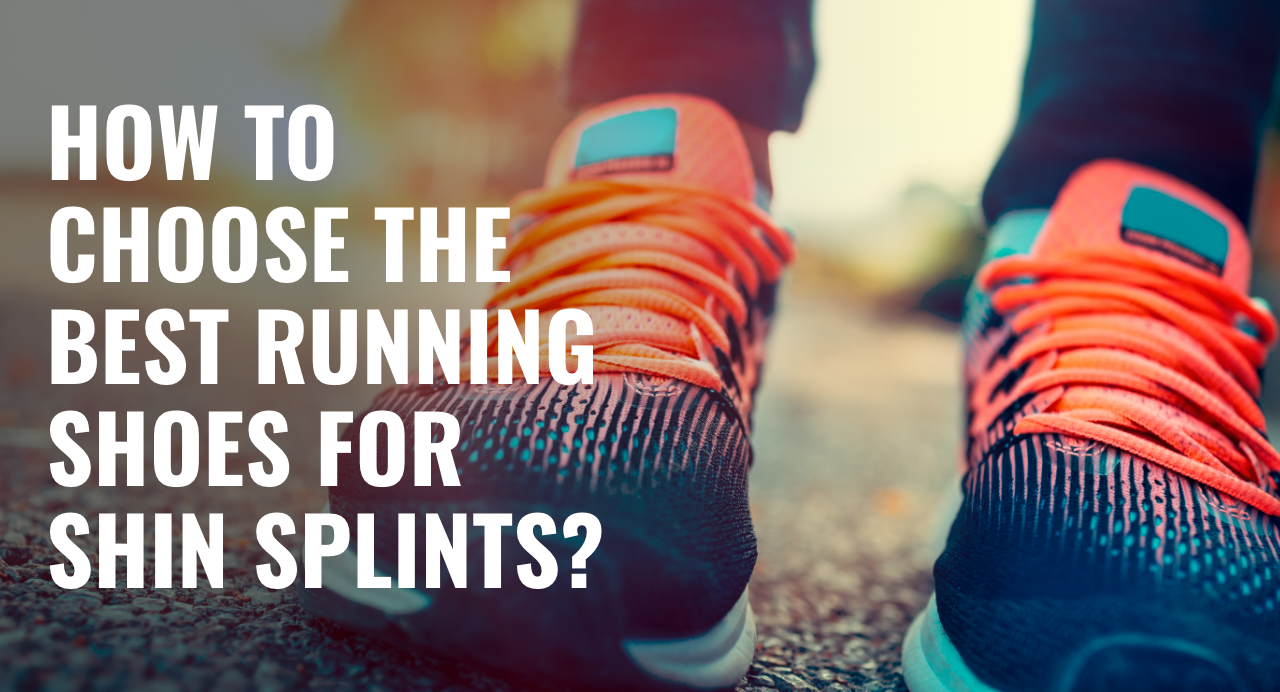How To Choose The Best
Running Shoes For Shin Splints?
Shin splints are a common ailment for runners of all levels, from the weekend warrior, trail runners, to the elite athlete. If you are experiencing some shin pain or pain in the front of your lower leg, you may be suffering from medial tibial stress syndrome, better known as "shin splints."
Even though there are many possible reasons for your leg pain, one of the greatest methods to prevent shin splints from setting in is by wearing the correct running shoe.
Here are some general guidelines for selecting the best running shoes, as well as some footwear suggestions for a better lifestyle and the prevention of shin splints.

Is Your Choice in Footwear Causing Shin Splints?
You're constantly on your feet because you enjoy being physically active. But for some time now, you've experienced an occasional soreness in your lower legs, and lately, it's been there more often than not. What's the matter? Shin splints may be the cause of your discomfort.
A shin splint is a typical problem and common injury for runners of all skill levels. However, it is more typical among rookie runners or those who have taken a hiatus from running.
If you want to keep your running lifestyle on track, you need to learn how to prevent and manage the condition. If you want to get started, you'll need to organize your exercises and wear the correct running shoes. In addition, there are other techniques to keep this injury from derailing your running schedule and performance. Keep reading to know more about the ideal pair of running shoes for your feet!
Will New Running Shoes Help With Shin Splints?
If you've developed shin splints, the shoes you wear may have contributed to your ailment. Here are a few techniques to prevent it from happening in the future.
To begin, dress appropriately for the amount of exercise or activities you plan to partake in. For beginner runners who decided to take up jogging, it's imperative that you get the right running shoes. A runner's footwear may be to blame for shin splints because they are designed for different activities.
What Causes Shin Splints?
Shin splints are a catch-all term for a variety of different kinds of injuries, such as that your tendons, bones, or muscles might be all inflamed. In addition, stress fractures may also occur as a result of overuse. Shin splints are more likely to occur if you run a lot in sports or do a lot of dancing, both of which put a lot of strain on your legs.
In an attempt to get rid of weight, you could abruptly ramp up your exercise routine and inadvertently cause shin splints by increasing the amount of stress on your calf muscles or leg muscles. Even so, it is possible to develop stress fractures or compartment syndrome as a result of really severe cases.
Run-and-jump exercises can cause repeated bouts of bone overload and early stress damage. Also, an inflamed bone membrane might cause soreness or pain if a person's body isn't prepared to handle the stress of an overworked system.
Tips for Finding the Best Running Shoes for Shin Splints
When it comes to running shoes, there is no such thing as a universal size. What type of shoe is appropriate for you depends on your foot structure, your running style, and the terrain you expect to run on. There are several things to keep in mind, though, if you are concerned about shin splints. The following are some elements to consider before picking the ideal running shoe.
Buy The Right Size of Running Shoe
With socks on, it's critical to get an accurate measurement of the length and breadth of your running shoes.
Allow at least a thumb's width between your longest toe and the end of the shoe for proper length. Can you pinch some of the shoe's material at the sides or top? Then you've found the right width. Your running shoe size is usually half a size larger than your regular shoe size.
Also, you'll want to try on a half-size larger running shoe once you've figured out your genuine shoe size and determined the length and width.
Match The Shape Of Your Footprint To Your Shoe
When working out or participating in sports, you can use your footprint to determine the type of shoe you'll need.
When you stand or walk, your entire foot should be in contact with the floor if your foot is flat. Only the ball and the heel of your foot will make contact with the floor if your arches are really high. When you're somewhere in between the two extremes, your footprint is neutral.
For example, overpronation is more common in people who walk with their feet flat on the ground. Overpronation can be prevented by wearing a high-stability, durable shoe with extra dense material in its middle.
In order to get the most out of a sport or activity, it is best to seek the advice of a knowledgeable shoe store like Lucky Feet Shoes, if you plan to begin a regular jogging program.
Custom orthotics might assist in alleviating the strain on your lower legs if you have flat feet. With the guidance of your orthotics, you'll be able to choose the right footwear for your legs and ankles.
Now, if the middle of your foot doesn't touch the ground or if you have really high arches, you need shoes that provide support, shock absorption, and extra cushioning to absorb the extra pressure.
Wear Shoes Designed Specifically For Running
You should get your feet checked out by a professional at a local running store and buy the right shoes for your stride and form.
Shin splints are common in those who use shoes that don't fit properly. To reduce the risk of injury, Lucky Feet Shoes offers a complete line of foot motion goods.
Find Shoes With Adequate Cushioning
You'll want shoes that provide enough padding. As a result of this increased padding, running on hard surfaces will be less painful. Shin splints can be prevented if you pay attention to how you land on your heels. Features like gel cushioning in shoes are great because not only do they provide plenty of cushioning in the soles, but also excellent shock absorption and reduce impact.
Buy Shoes That Match Your Gait and Form
Your running shoe's fit is perhaps the most crucial consideration. How well-versed are you on your own foot? What's the size? Is it because of its size? What are the mechanics behind this? The moment has come to look beyond your shoe size if you haven't done so already. It is especially important to understand the relationship between your arches and muscles, and tendons when it comes to shin splints.
It's definitely not a good idea to buy shoes that don't fit properly and then attempt to break them in. If they don't, they won't be able to store them at the store. Running causes your feet to expand, so leave enough room between your toes so that you can comfortably wiggle them. For that, always go for shoes with a roomy or wide toe box.
How to Avoid Shin Splints?
Shin splints don't necessarily begin in a horrible way. When it comes to running ailments, shin splints may take time to become debilitating. A common ailment for runners is tendon and muscle soreness around the shin bone, which can be felt either on the front or rear of the leg. You're also aware of the debilitating effect that scorching lower-leg pain can have on your training and your ability to compete.
Give Your Shins Appropriate Rest
All actions that produce pain, edema, or discomfort should be stopped immediately. In most cases, active rest is sufficient to treat shin splints, but you should consult a physician if you suspect a more serious injury has occurred. Swimming, for example, is a low-impact activity that can help alleviate your pain.
Ease Yourself Into Running After A Rest Period
It's possible that you can continue to run, but you'll need to reduce the distance and frequency of your workouts. In addition, you should reduce your running effort by around 50%.
Change The Surface You Run or Jog On
Hills, uneven surfaces, and hard surfaces, such as cement, should all be avoided. Treadmill running may be a safe option if you have access to one.
Low-impact exercises like swimming, pool running, or biking may also assist until your pain goes away.
Top 6 Best Running Shoes For
Women
HOKA Bondi 7 Running Shoes
With their thick and wide soles, the Bondi 7 is the most cushioned HOKA road shoe and provides a smooth, balanced ride. The Bondi 7 has the same full EVA midsole, breathable mesh upper, and trademark Meta-Rocker technology as its predecessor. Ultra-soft memory foam fits a wide variety of ankles, cushioning the Achilles in comfort. Bondi 7 will take you far.
HOKA Gaviota 3 Running Shoes
The Hoka One One® Gaviota 3 over-delivers on plushness, with two additional millimeters of foam than its predecessor. This versatile road shoe offers a balanced ride over any distance. Engineered mesh delivers breathable comfort. Also, late-stage balanced Meta-Rocker geometry creates a unique fulcrum effect that encourages a smoother transition from heel-strike through toe-off.
HOKA Arahi 6 Running Shoes
Lightweight. Stable. Unmatched. The Arahi returns with the same stabilizing J-Frame™ as before. It has a pull tab, breathable mesh upper, maximum cushioning, and low weight. The Arahi 6 is a lightweight, comfortable support shoe for runners. The HOKA Arahi 6 is fluffy and supportive.
Brook’s Ghost 14 Running Shoes
The Brooks Ghost is still one of our favorite sneakers, but it's now even softer and smoother. New cushioning technology in this redesigned women's running shoe provides a pleasant, smooth ride from the moment you put them on. If you plan on doing a lot of road running or gentle landings, the Brooks Ghost 14 Running Shoes are the shoes for you. On top of that, the Ghost 14 is Brooks' first carbon neutral shoe.
Brook’s Adrenaline Running Shoes
The women's Brooks Adrenaline offers a soft, comfortable ride that's ready for all of your kilometers, thanks to its design to provide the perfect blend of support and softness. No wonder they've been a runner favorite for almost two decades: they're supportive and comfortable.
New Balance 990 Running Shoes
In addition to running, the New Balance 990 Running Shoes are ideal for standing, walking, and other non-striding activities. Overpronators and weekend warriors who only run three to four miles at a time may find the 990 Heritage useful as a primary running shoe for their heavy feet. For overpronators recovering from foot injuries or battling arthritis, we believe these shoes could be an excellent option.
FAQ
Can shin splints be caused by the wrong shoes?
Those who begin a new sport or training regimen are more likely to suffer from shin splints as muscles and tendons adapt to the increased use. Putting on shoes that don't provide adequate support would be a way to make that worse. So it's possible that even running shoes that don't provide adequate support and cushioning are contributing factors.
Do I have to wear compression socks with my running shoes?
Leg and foot pain is eased with the use of compression socks, which are popular among runners. In the aftermath of marathons and ultramarathons, compression socks have been shown to help minimize muscle injury and inflammation.
Are shin splints permanent?
This condition is not long-lasting. Make sure you are wearing supportive footwear to alleviate pain from the injury. Rest is also an important part of this process. Consult your physician if your shin splints persist despite your best efforts.
Are all shoes for shin splints the same?
When it comes to running shoes for shin splints, there isn't a one-size-fits-all solution. Your running style, foot structure (if you have wide feet or narrow feet, high arch or flat feet, etc), and the terrain you'll be running on all factor into which shoe is best for you. There are several things to keep in mind, though, if you are concerned about shin splints. Shin splints can be made worse by excessive foot pronation.

Jerick Sobie
Since 2005, I have been a dedicated small business owner specializing in footwear retail. With over 20 years of experience, my business partner and I have helped customers find the perfect shoes that combine style, comfort, and quality. Our expertise extends beyond local sourcing—we have traveled internationally to discover high-quality footwear that meets our customers’ needs. In addition to running my business, I have participated in numerous health fairs and educational seminars, sharing my knowledge on proper footwear and foot health. Committed to providing exceptional service, We carefully curate our selections to ensure the best fit and support for every customer.





































































